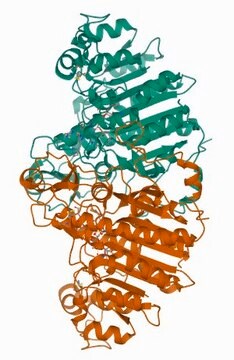F3290
FLAG® Peptide
≥85% (HPLC), lyophilized powder
Synonym(s):
Asp-Tyr-Lys-Asp-Asp-Asp-Asp-Lys, ddddk peptide, dykddddk peptide
About This Item
Recommended Products
product name
FLAG® Peptide, lyophilized powder
Assay
≥85% (HPLC)
Quality Level
form
lyophilized powder
mol wt
1012.97 Da
shipped in
wet ice
storage temp.
2-8°C
SMILES string
NCCCC[C@H](NC(=O)[C@H](CC(O)=O)NC(=O)[C@H](CC(O)=O)NC(=O)[C@H](CC(O)=O)NC(=O)[C@H](CC(O)=O)NC(=O)[C@H](CCCCN)NC(=O)[C@H](Cc1ccc(O)cc1)NC(=O)[C@@H](N)CC(O)=O)C(O)=O
InChI
1S/C41H60N10O20/c42-11-3-1-5-22(45-36(65)24(13-19-7-9-20(52)10-8-19)47-34(63)21(44)14-29(53)54)35(64)48-26(16-31(57)58)38(67)50-28(18-33(61)62)40(69)51-27(17-32(59)60)39(68)49-25(15-30(55)56)37(66)46-23(41(70)71)6-2-4-12-43/h7-10,21-28,52H,1-6,11-18,42-44H2,(H,45,65)(H,46,66)(H,47,63)(H,48,64)(H,49,68)(H,50,67)(H,51,69)(H,53,54)(H,55,56)(H,57,58)(H,59,60)(H,61,62)(H,70,71)/t21-,22-,23-,24-,25-,26-,27-,28-/m0/s1
InChI key
XZWYTXMRWQJBGX-VXBMVYAYSA-N
General description
Application
Learn more product details in our FLAG® application portal.
Preparation Note
Legal Information
Storage Class Code
11 - Combustible Solids
WGK
WGK 3
Flash Point(F)
Not applicable
Flash Point(C)
Not applicable
Personal Protective Equipment
Regulatory Listings
Regulatory Listings are mainly provided for chemical products. Only limited information can be provided here for non-chemical products. No entry means none of the components are listed. It is the user’s obligation to ensure the safe and legal use of the product.
JAN Code
F3290-25MG-PW:
F3290-25MG:
F3290-4MG-PW:
F3290-4MG:
F3290PROC:
F3290-4MG-KC:
F3290-BULK-N:
F3290-PH:
F3290-BULK:
F3290-VAR:
Certificates of Analysis (COA)
Search for Certificates of Analysis (COA) by entering the products Lot/Batch Number. Lot and Batch Numbers can be found on a product’s label following the words ‘Lot’ or ‘Batch’.
Already Own This Product?
Find documentation for the products that you have recently purchased in the Document Library.
Customers Also Viewed
Related Content
Protein purification techniques, reagents, and protocols for purifying recombinant proteins using methods including, ion-exchange, size-exclusion, and protein affinity chromatography.
Protein expression technologies for expressing recombinant proteins in E. coli, insect, yeast, and mammalian expression systems for fundamental research and the support of therapeutics and vaccine production.
Our team of scientists has experience in all areas of research including Life Science, Material Science, Chemical Synthesis, Chromatography, Analytical and many others.
Contact Technical Service











